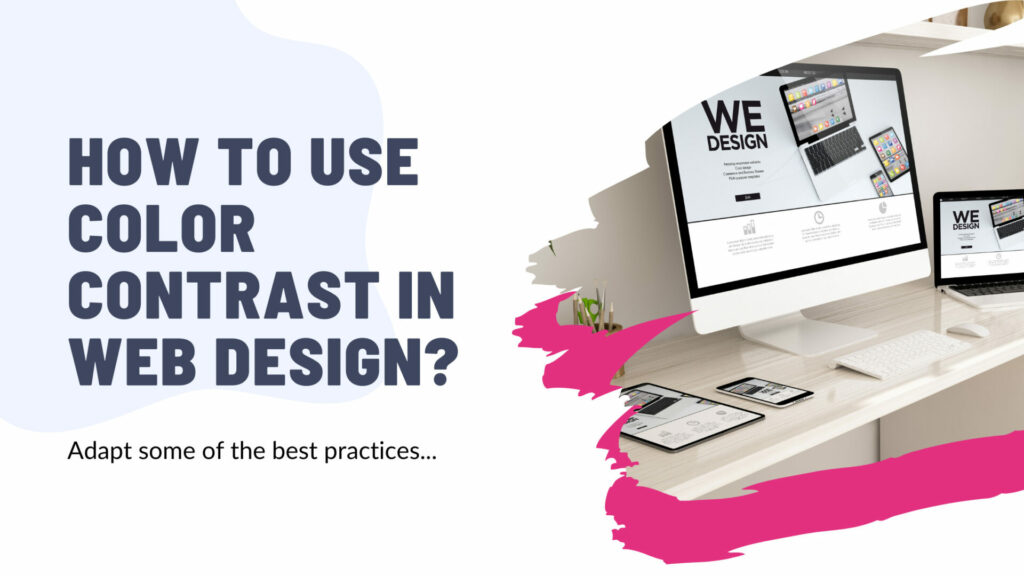Color is a fundamental element in web design. It sets the mood, establishes brand identity, and guides users through your website. But beyond aesthetics, color plays a crucial role in readability and accessibility. Using the right color contrast ensures your website is not only visually appealing but also easy to navigate and understand for everyone.
Understanding Color Contrast
Color contrast refers to the difference in light and dark values between two colors. Imagine a black text on a white background – that’s high contrast, where the colors are easily distinguishable. Conversely, light gray text on a white background creates low contrast, making the text appear blurry or washed-out. Effective web design relies on utilizing a balance of both for optimal user experience.
Why Color Contrast Matters in Web Design
Color contrast is much more than just an aesthetic choice. Here’s why it plays a vital role in successful web design:
- Readability: High color contrast ensures text and essential website elements are clearly visible against their background. This is crucial for users with visual impairments or those browsing on low-brightness devices. Imagine struggling to read important information because the text color blends into the background – a frustrating user experience that can be easily avoided with proper color contrast.
- Accessibility: Proper color contrast adheres to accessibility guidelines set by organizations like the World Wide Web Consortium (W3C). This ensures your website is inclusive for users with varying visual abilities. By ensuring sufficient contrast, you’re creating a website that everyone can use and navigate effectively.
- Usability: Clear contrast improves user navigation and comprehension. When elements are easily distinguishable, users can quickly find the information they need and interact effectively with your website. A website with poor color contrast can be confusing and frustrating to navigate, leading users to abandon it altogether.
- Visual Hierarchy: Strategic use of color contrast can create a visual hierarchy, guiding users’ attention towards important elements like calls to action (CTAs) or key information. Imagine a brightly colored button contrasting against a muted background – it naturally draws the eye and encourages user interaction. Color contrast allows you to guide users through your website and ensure they don’t miss crucial information.
Techniques for Effective Color Contrast in Web Design
Now that we understand the importance of color contrast, let’s explore some techniques to implement it effectively:
- Color Contrast Checkers: Technology is your friend! Utilize online tools like WebAIM’s Color Contrast Checker or APCA Contrast Checker to assess the contrast ratio between your chosen colors. These tools provide instant feedback on whether your color combination meets accessibility standards. Aim for a contrast ratio of at least 4.5:1 for normal text and 3:1 for large text or graphics.
- Color Palettes: Don’t reinvent the wheel! Leverage pre-designed color palettes that guarantee sufficient contrast. Many design tools offer built-in palettes or allow you to generate contrasting color combinations. This is a great way to ensure accessibility while still achieving the desired aesthetic for your website.
- Light vs. Dark Themes: Consider implementing a theme switcher to allow users to choose between a light or dark background theme based on their preference. This caters to users with visual sensitivities who might find one theme easier on their eyes. Providing options demonstrates user-friendliness and inclusivity.
- Consider Color Blindness: Be mindful of color blindness when choosing color combinations. Tools like Coblis Color Simulator allow you to simulate how your website appears to users with different types of color blindness. This extra step ensures your website is accessible to a wider audience and avoids unintentional exclusion.
Beyond the Basics: Using Color Contrast Creatively
While ensuring accessibility is paramount, color contrast can also be used strategically to enhance your design:
Highlight Calls to Action (CTAs): Utilize high-contrast combinations to make buttons or CTAs stand out, encouraging user interaction. Imagine a bright red button contrasting against a blue background – it naturally grabs attention and compels users to click.
Create Visual Interest: Employ contrasting colors for different sections of your website to create visual interest and guide users through the content flow. For example, a section with bold purple headings contrasting against a light gray background can visually separate it from the main content area.
Evoke Emotions: Colors have psychological associations. Consider these associations when choosing contrasting color combinations to evoke specific emotions or create a desired brand perception. For example, a combination of blue and green might evoke feelings of calmness and trust, while red and orange can create a sense of urgency or excitement.
Conclusion
By understanding color contrast and implementing it effectively, you can create a website that is not only visually striking but also accessible and user-friendly for everyone. Remember, color contrast serves both aesthetic and practical purposes, playing a vital role in crafting a successful web design strategy. So go forth and use the power of color contrast to create a website that informs, engages, and delights your visitors!

